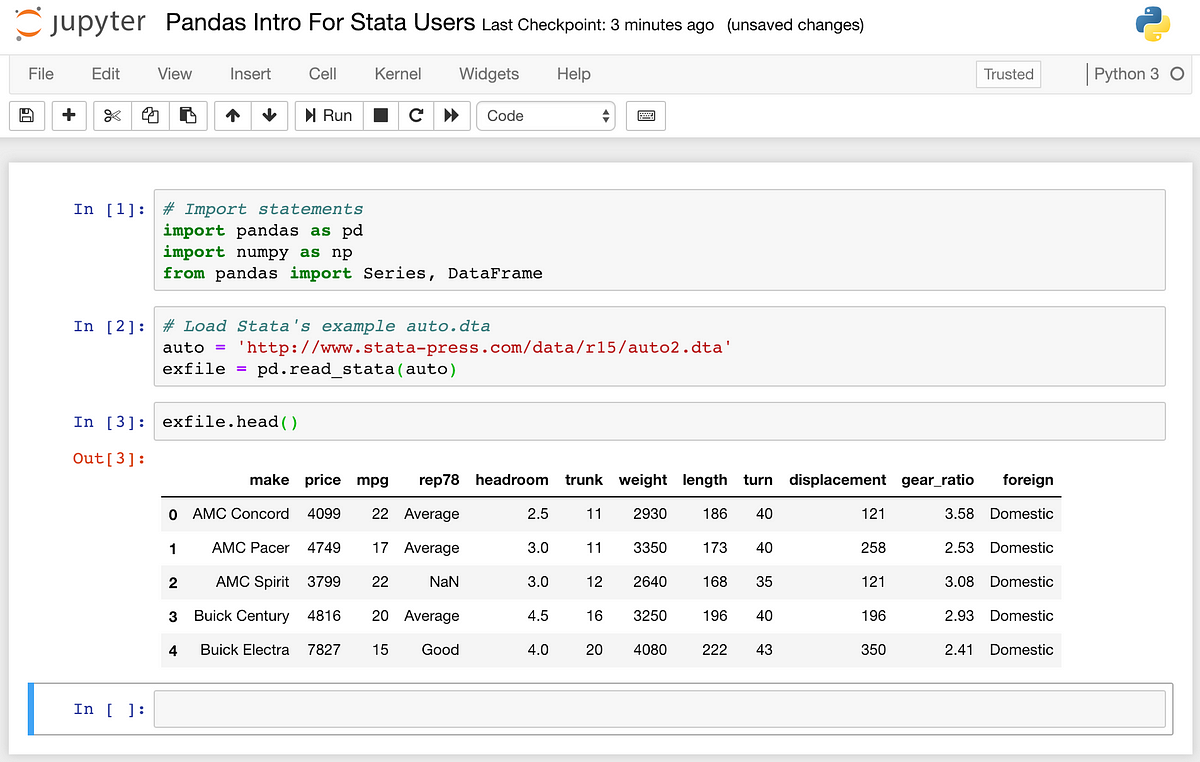- Basically, Stata is a software that allows you to store and manage data (large and small data sets), undertake statistical analysis on your data, and create some really nice graphs. This software is commonly used among health researchers, particularly those working with very large data sets, because it is a powerful software that allows you to.
- Note that the dashed lines appear as solid lines in Stata's results window: Standard errors, p-values, and summary statistics. The default in esttab is to display raw point estimates along with t statistics and to print the number of observations in the table footer. To replace the t-statistics by, e.g., standard errors and add the adjusted R.
- Stata SE and MP are available on the research cluster. You can request a cluster account by going to research.uit.tufts.edu and submitting the application form. Before accessing Stata on the cluster, please contact Tufts Technology Services at 617-627-3376 or it@tufts.edu for an assessment of whether or not your computer’s display meets Stata.
- CITL Data Analytics (Illinois login required)The Center for Innovation in Teaching and Learning's Data Analytics group maintains how-to guides on common statistical procedures in Stata and other software. CITL also sponsors workshops on common analysis programs.
- Stata TrainingStataCorp's training materials include videos, webinars, and on-site training. Fees apply to some services.
- Princeton Stata TutorialA tutorial provided by Princeton that introduces beginners to basic commands, data management, graphs, and advanced techniques.
- StataCorp Main Support PageAccess official Stata documentation, tutorials, resources, and more.
- Stata FAQFrequently asked questions on Stata's official webpage.
- UCLA TutorialThe Institute for Digital Research and Education at UCLA provides class notes on a range of topics from basic to advanced data management and analysis techniques.
- Official Stata Channel on YouTubeVideo tutorials of many statistical functions in Stata.
- Quick GuideFound on the University of Pennsylvania's Stata Library Guide
STATA: A Brief Introduction to using Stata with MS Windows
Stata Tutorial: Introduction to Statahttps://sites.google.com/site/econometricsacademy/econometrics-software/stata. The aim of this document is to provide an introduction to Stata, and to describe the requirements necessary to undertake the basics of data management and analysis. This document is designed to complement rather.
A. Colin Cameron, Dept. of Economics, Univ. of Calif. - Davis
This January 2009 help sheet gives information on- Data Sets in Stata
- Interactive Use
- Reading in a Stata dataset
- Reading in a Non-Stata dataset (a csv file)
- Summary statistics
- Linear Regression
- Twoway scatterplot with fitted regression line
- Stata do-file (A Script or program or Batch File)
- Help in Stata
STATA ACCESS AT U.C.-DAVIS
Some but not all UCD computer labs have Stata.
Schedules are available at http://clm.ucdavis.edu/rooms/
You need a campus computing account: https://computingaccounts.ucdavis.edu/cgi-bin/services/index.cgi
Stata stores data in a special format that cannot be read by other programs.
Stata data files have extension .dta
Stata can read data in several other formats.
A standard format is a comma-separated values file with extension .csv (which can be created by Excel for example).
INTERACTIVE USE
This is similar to using Excel.
[Additionally one can combine commands in a file and execute the file.
This faster method for more experienced users is presented at the end of this file].
Interactive use can be initiated in several ways
- Click on the Stata icon in MS windows
- Click on the name of a file containing a Stata dataset (with extension .dta)
- Click on the name of a file containing a Stata do-file (with extension .do)
Commands can be entered using the menus and consequent dialog boxes at the top.
Or commands can be typed in the Command line at the bottom.
READING IN A STATA DATA SET
Consider data in the Stata date file carsdata.dta
Here we suppose the file is in directory C:stata (so the file is C:statacarsdata.dta)
1. The simplest method is in Windows go to the directory with file carsdata.dta and double-click on carsdata.dta
This initiates Stata and opens the data file.
2. Alternatively start STATA in Windows.
In the command line give the commands
cd C:stata
use carsdata.dta
or even more simply give the command
use 'C:statacarsdata.dta'
3. Alternatively start STATA in Windows.
Use the File Menu and the Open submenu and browse to find the file and click on the file.
For more details see statareadinstatadataset.html
In all cases we obtain
READING IN A NON-STATA DATA SET: A CSV FILE
 Stata can read in some other types of data file than a Stata dataset.
Stata can read in some other types of data file than a Stata dataset.It cannot read in an Excel spreadsheet (with extension .xls or .xlsx).
A standard alternative format is a comma-separated file or comma-delimited file (with extension .csv).
For example in Excel an Excel worksheet can be saved as a .csv file.

An example is file carsdata.csv
S
Www.statarea.com
tart STATA in Windows.In the command line give the commands
cd C:stata
insheet using carsdata.csv
or even more simply give the command
insheet using 'C:statacarsdata.dta'
Alternatively Use the File Menu and the Import submenu.
Choose ASCII data created by a data sheet
And browse to find the .csv file and click on the file.
SUMMARY STATISTICS
To obtain summary statistics we can simply type in the command line
summarize
and hit <enter>.
Alternatively we can use the Stata Statistics menu and subsequent submenus:
Then hit on summary statistics to get:
To obtain summary statistics for all variables simply hit the OK button.
This yields
There are five observations on two variables: cars and hhsize.
Summary statistics provided are the mean, standard deviation, minimum and maximum.
Additional statistics would have been displayed if we had checked Display additional statistics.
LINEAR REGRESSION
To regress variable cars on variable hhsize simply type in the command line
regress cars hhsize
and hit <enter>.
Then choosing Linear Regression yields a dialog box that we fill out as follows:
Hit OK (or directly give command regress cars hhsize) yields output
The estimated regression line is
cars = 0.8 + 0.4*hhsize
TWOWAY SCATTERPLOT WITH FITTED REGRESSION LINE
 This can be obtained using the command
This can be obtained using the commandtwoway (scatter cars hhsize) (lfit cars hhsize)
Alternatively use the Graphics menu and the Twoway Graph (scatter, line, etc.) submenu.
STATA DO-FILE (A Script or program or Batch File)
Stata commands can be combined in a text file with extension .do called a do-file.
The file carsdata.do has the following text
* Stata do-file carsdata.do written January 2009
* Create a text log file that stores the results
log using carsdata.txt, text replace
* Read in the Stata data set carsdata.dta
use carsdata.dta
* Describe the variables in the data set
describe
* List the dataset
list
* Provide summary statistics of the variables in the data set
summarize
* Provide an X,Y scatterplot with a regression line
Stata Free Download
twoway (scatter cars hhsize) (lfit cars hhsize)
* Save the preceding graph in a file in PNG (portable networks graphic) format
graph export carsdata.png
* Regress cars on hhsize
regress cars hhsize
The lines beginning with * are explanatory comments that are ignored by Stata.
To run this do-file simply click in Windows on filename carsdata.do
This file needs to be in the same directory as file carsdata.dta
 Alternatively, start Stata, give command cd C:stata (if file carsdata.do and carsdatat,dta are in directory C:Stata)
Alternatively, start Stata, give command cd C:stata (if file carsdata.do and carsdatat,dta are in directory C:Stata)and then give command
do carsdata.do
The program does the preceding analysis.
Stata
Results are put in the text file carsdata.txt
HELP IN STATA
Stata Software
Stata provides extensive documentation on-line.
For example, to obtain help on the command summarize, in the command line type
help summarize
Alternatively use the Help menu
For further information on how to use STATA go to
http://cameron.econ.ucdavis.edu/stata/stata.html